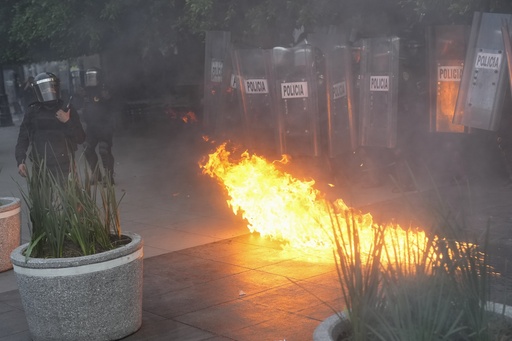
MEXICO CITY (AP) — Mexico’s new President Claudia Sheinbaum started her day Wednesday much like her political mentor, ex-President Andrés Manuel López Obrador, began most of his: with an early morning news briefing from the National Palace.
López Obrador’s news briefings, known as the “mañaneras,” were marathon affairs, featuring folksy dialogue, verbal jousting with the press, and, frequently, long history lessons. His oratorical skills turned his 2 1/2-hour-long daily mañaneras into a powerful political weapon.
Sheinbaum kept her morning briefing shorter, less combative and more concise, in keeping with her character as a scientist and academic.
She said she would keep some of her predecessor’s fixtures, like a weekly segment attacking what she called media “lies” about the government. The new president also continued a diplomatic dispute with Spain — which has refused to apologize for abuses during the 1500s conquest of Mexico — that many thought she would try to defuse.
Sheinbaum also continued López Obrador’s efforts to downplay drug cartel violence in the northern state of Sinaloa, saying it was not among the states with the highest number of murders this week.
It’s no surprise that Sheinbaum decided to continue with the successful formula of her mentor — she has promised to continue virtually everything he did. She will hope to set the press’s daily agenda just as López Obrador did throughout his presidency.
After her June 2 election victory, the former Mexico City mayor began holding midday news briefings that concluded within half an hour. Sheinbaum would open with announcements and then take questions from journalists.
In Wednesday’s first press conference, Sheinbaum was a bit more punctual in her responses and, unlike López Obrador, didn’t use questions as a pretext for half-hour discourses on obscure chapters of Mexican history.
But she did open her first press conference with a governmental apology on the 56th anniversary of the Oct. 2, 1968 army massacre of student pro-democracy protesters in Mexico City’s Tlatelolco square in which as many as 300 people were killed.
Sheinbaum revealed that her mother had participated in the movement and had been expelled from a state-run university in retaliation.
“I have said before, I am a child of ‘68,” Sheinbaum said, calling her memories of the period — when she was 6 years old — “something very painful.”
During his presidency, which concluded Monday, the 70-year-old López Obrador held daily briefings Monday through Friday, combining jokes and harshness and, often, attacking journalists critical of his administration, publishing reporters’ phone numbers and personal financial data.
But Sheinbaum, a 62-year-old scientist-turned-politician, has another style.
“As a communicator she’s different,” said Roy Campos, president of the polling company Consulta-Mitofsky. He said Sheinbaum has a “spare” speaking style. She transmits an image of “a university professor who tries to demonstrate seriousness and truth through science,” he added.
That’s a far cry from the folksy López Obrador, who would speak for hours, with lots of colloquial language, and he enjoyed publicly confronting his adversaries.
Through his powerful speeches, López Obrador managed to leave office with an approval rating still above 60%. His legacy makes him one of Mexico’s most popular presidents in recent history.
Now the question arises as to whether Sheinbaum will be able to capture the attention and win the empathy that López Obrador consolidated during his six-year term.
Campos said it all depends on how she will come across in front of the cameras.
“She will try to create that empathy that López Obrador created,” he said. “We’re going to see if this daily presence will give her control of the press agenda or popularity.”
____
Follow AP’s coverage of Latin America and the Caribbean at https://apnews.com/hub/latin-america

